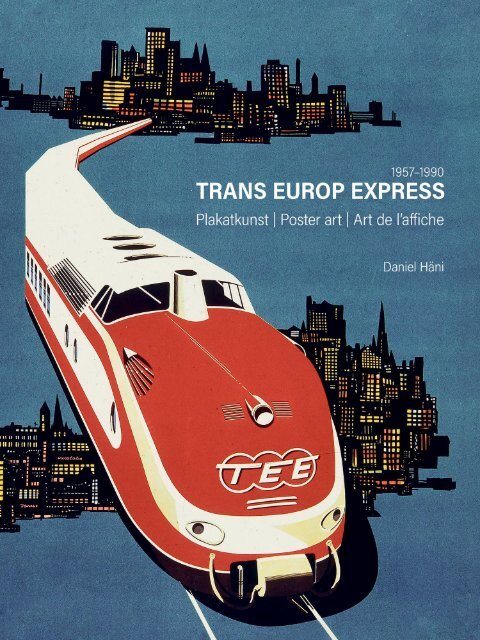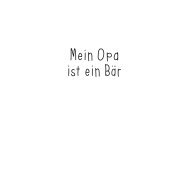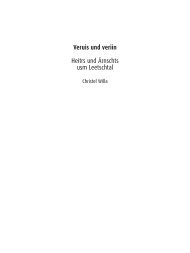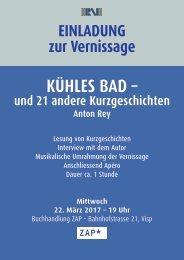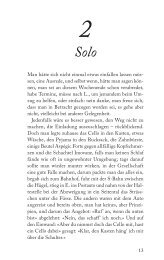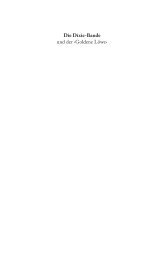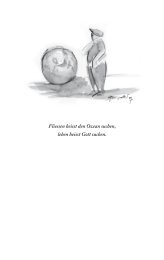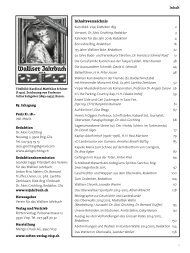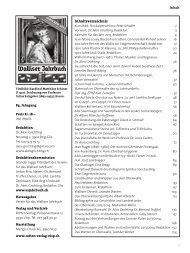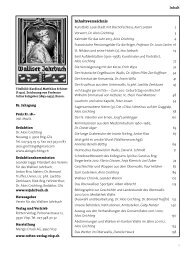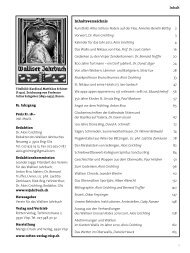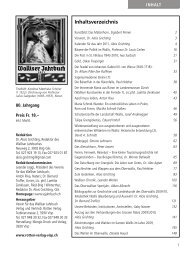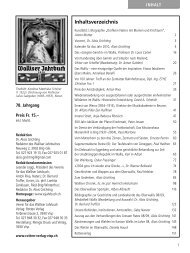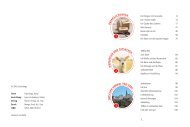TEE-Plakate_Leseprobe
You also want an ePaper? Increase the reach of your titles
YUMPU automatically turns print PDFs into web optimized ePapers that Google loves.
Impressum<br />
© 2017, Daniel Häni, Oberrieden<br />
Gestaltung und Satz: Bettina Zanella, Mengis Druck und Verlag AG, Visp<br />
Übersetzung Englisch: Rod Chuck, Glis<br />
Übersetzung Französisch: Anne-Marie Keck, Dielsdorf<br />
Herstellung: Mengis Druck und Verlag AG, Visp<br />
Verlag: Rotten Verlags AG, Visp<br />
ISBN: 978-3-906118-51-2<br />
Umschlagbild: Auf Grundlage des WER-<strong>Plakate</strong>s 11/63, DB Museum, Nürnberg<br />
Das Werk einschliesslich aller Inhalte ist urheberrechtlich geschützt. Alle Rechte vorbehalten.<br />
Nachdruck oder Reproduktion (auch auszugsweise) in irgend einer Form<br />
(Druck, Fotokopie oder anderes Verfahren) sowie die Einspeicherung, Verarbeitung,<br />
Vervielfältigung und Verbreitung mit Hilfe elektronischer Systeme jeglicher Art, gesamt<br />
oder auszugsweise, ist ohne ausdrückliche schriftliche Genehmigung des Verlages untersagt.<br />
Alle Übersetzungsrechte vorbehalten.<br />
Das Werk inklusive aller Inhalte wurde unter grösster Sorgfalt erarbeitet. Dennoch können<br />
Druckfehler und Falschinformationen nicht vollständig ausgeschlossen werden.<br />
Der Verlag und auch der Autor übernehmen keine Haftung für die Aktualität, Richtigkeit<br />
und Vollständigkeit der Inhalte des Buches, ebenso nicht für Druckfehler. Es kann<br />
keine juristische Verantwortung sowie Haftung in irgendeiner Form für fehlerhafte Angaben<br />
und daraus entstandenen Folgen vom Verlag bzw. Autor übernommen werden.<br />
The work including all contents are protected by copyright. All rights reserved. Reprinting<br />
or reproduction (even of extracts) of any kind, (printing, photocopying or other<br />
processes) as well as storage, processing, copying and distribution with the aid of<br />
electronic systems of any kind, either wholly or in extracts, is not permitted without the<br />
express written permission of the publisher. All translation rights reserved.<br />
The work including all contents has been prepared with great care. Nevertheless,<br />
printing errors and incorrect information cannot be completely ruled out. Neither the<br />
publisher nor the author accept any liability for the topicality, correctness and completeness<br />
of the contents of the book, nor for any printing errors. No legal responsibility<br />
or liability in any form can be accepted by the Publishing Company or the author<br />
respectively for faulty information and any consequences arising from this.<br />
L’ouvrage ainsi que son contenu sont protégés par la législation sur les droits d’auteur.<br />
Tous droits réservés. Toute réimpression ou reproduction (même d’extraits) sous quelque<br />
forme que ce soit (impression, photocopie ou autre méthode), ainsi que la sauvegarde,<br />
transformation, polycopie et publication grâce à un système électronique quel qu’il soit,<br />
en entier ou en extraits, sont formellement interdites sans une autorisation explicite par<br />
écrit de l’éditeur. Tous droits de traduction réservés.<br />
L’ouvrage et son contenu ont été conçus avec le plus grand soin. Cependant, certaines<br />
fautes d’impression ou erreurs d’informations ne peuvent être exclues. L’éditeur<br />
et l’auteur déclinent toute responsabilité quant à l’actualité, l’exactitude et l’intégralité<br />
du contenu de l’ouvrage, ainsi qu’en cas d’éventuelles fautes d’impression.<br />
Aucune responsabilité juridique ou de quelque ordre que ce soit, en cas de données<br />
inexactes et des conséquences qui en résulteraient ne peuvent être assumées par<br />
l’éditeur ni par l’auteur.
1957–1990<br />
TRANS EUROP EXPRESS<br />
Plakatkunst | Poster art | Art de l’affiche<br />
Daniel Häni<br />
Terbinerstr. 2, 3930 Visp<br />
Terbinerstr. 2, 3930 Visp
Inhaltsverzeichnis Table of<br />
contents Sommaire<br />
Vorwort<br />
Foreword<br />
Das Plakat – ein Kulturgut<br />
The poster – a cultural heritage<br />
Im Spiegel des Plakats<br />
Reflection on the poster<br />
Europa und seine Bahnen<br />
Europe and its railways<br />
Trans Europ Express (<strong>TEE</strong>)<br />
<strong>TEE</strong>-Logos<br />
1957–1965 Beginn der <strong>TEE</strong>-Ära<br />
1966–1977 Erweiterung und Zenit<br />
1978–1990 Der Wandel zum EuroCity<br />
Komfortzüge in Österreich<br />
Trans Europ Express (<strong>TEE</strong>)<br />
<strong>TEE</strong>-Logos<br />
1957–1965 Beginning of the <strong>TEE</strong> era<br />
1966–1977 Expansion and zenith<br />
1978–1990 Transition to the EuroCity<br />
Comfort trains in Austria<br />
Trans Euro Nacht (TEN)<br />
Trans Euro Night (TEN)<br />
Trans Europ Express Marchandises (<strong>TEE</strong>M)<br />
Trans Europ Express Marchandises (<strong>TEE</strong>M)<br />
Anhang<br />
Biografien<br />
Bildnachweis<br />
Literaturnachweis<br />
Abkürzungen<br />
<strong>TEE</strong>-Verbindungen<br />
Appendix<br />
Biographies<br />
Picture credits<br />
Bibliography<br />
Abbreviations<br />
<strong>TEE</strong> connections<br />
Dank<br />
Acknowledgments
Préface 6<br />
L’affiche – un patrimoine culturel 10<br />
Le reflet de l’affiche 16<br />
L'Europe et ses chemins de fer 24<br />
Trans Europ Express (<strong>TEE</strong>) 34<br />
Les Logos <strong>TEE</strong> 40<br />
1957–1965 Début de l’ère <strong>TEE</strong> 46<br />
1966–1977 Expansion et apogée 76<br />
1978–1990 Reconversion en EuroCity 124<br />
Trains de confort en Autriche 136<br />
Trans Euro Nuit (TEN) 148<br />
Trans Europ Express Marchandises (<strong>TEE</strong>M) 166<br />
Appendice 184<br />
Biographies 186<br />
Crédits photos 192<br />
Bibliographie 194<br />
Abréviations 196<br />
Liaisons <strong>TEE</strong> 198<br />
Remerciements 202
Vorwort Foreword Préface<br />
6<br />
<strong>TEE</strong> – Ein (zu) futuristisches Konzept<br />
Es war zur Zeit des Wirtschaftswunders. Die Ziele des<br />
neuen Mittelstandes waren das Einfamilienhaus, das<br />
Auto und der Fernsehapparat. Der Flugverkehr begann<br />
sich zaghaft zu entwickeln. Die Bahn war das Verkehrsmittel<br />
von gestern. Es war der Initiative des Präsidenten<br />
der Niederländischen Staatsbahn zu verdanken, dass<br />
1954 die «Trans Europ Express-Kommission» gegründet<br />
wurde. Mit dabei die Bahnen von Belgien, Deutschland,<br />
Frankreich, Italien, Luxemburg, der Niederlande und der<br />
Schweiz. Ziel war ein Bahnangebot mit möglichst kurzen<br />
Reisezeiten zwischen den Metropolen und Tourismusorten<br />
dieser Länder. Das war angesichts der Vielfalt von<br />
Stromsystemen und nationalen Vorschriften sehr ambitioniert.<br />
Dass es gelungen ist, ein einheitliches Erscheinungsbild<br />
zu definieren, ist erstaunlich. Das Markenzeichen<br />
der <strong>TEE</strong>-Express-Züge wurde die Farbkombination<br />
«Weinrot/Eierschalenbeige». Die Züge boten ausschliesslich<br />
1. Klasse und mindestens 120 Sitzplätze an.<br />
Die Schweizer Rollmaterial-Industrie entwickelte zusammen<br />
mit der SBB den RAe <strong>TEE</strong> II, einen Triebzug, der unter<br />
vier verschiedenen Stromsystemen fahren kann. Sein<br />
Design bestach aussen und innen durch zeitlose Eleganz.<br />
Wann hat es je einen Zug gegeben mit einer separaten<br />
Damentoilette mit Schminkecke? Die Schönheit liegt im<br />
Auge des Betrachters, und in meiner persönlichen Meinung<br />
war der <strong>TEE</strong> II der schönste und komfortabelste Zug<br />
der schweizerischen Bahngeschichte.<br />
Der Kern des <strong>TEE</strong>-Konzepts war der Aufbau einer europäischen<br />
Marke. Die in diesem Buch abgebildeten <strong>Plakate</strong><br />
zeigen, wie gut das gelungen ist. Und doch scheiterte das<br />
Konzept nach relativ kurzer Zeit, weil das Produkt zwei<br />
fundamentale Mängel hatte. Der Zug mit ausschliesslich<br />
1. Klasse fand keine ausreichende Nachfrage. Und die<br />
Züge verfügten über zu wenig Sitzplätze. Der <strong>TEE</strong> II hatte<br />
126 Sitzplätze, das entsprach einem mittleren Flugzeug<br />
oder zwei Reisebussen. Damit wurde der Vorteil der Bahn<br />
im Massenverkehr preisgegeben.<br />
Die Marke <strong>TEE</strong> wurde durch die Marke EuroCity abgelöst.<br />
Diese erreichte nie auch nur annähernd die Strahlkraft<br />
des <strong>TEE</strong>. Es sind heute wieder einzelne Verbindungen<br />
wie der Eurostar, der TGV Lyria oder Thalys, welche die<br />
europäische Bahnlandschaft prägen. Von einem einheitlichen<br />
Netz von Qualitätszügen in Europa, geschweige<br />
denn einer einheitlichen, starken Dachmarke können wir<br />
heute nur noch träumen.<br />
<strong>TEE</strong> – A (too) futuristic concept<br />
It was the time of the economic miracle. The goals of the<br />
new middle class were a detached house, the car and<br />
the television. Air traffic began to develop tentatively. The<br />
railway was yesterday’s mode of transport. It was thanks<br />
to the initiative of the chairman of Holland’s national<br />
railways, that in 1954 the “Trans Europ Express Commission”<br />
was founded. Also participating were the railways<br />
of Belgium, Germany, France, Italy, Luxembourg, Holland<br />
and Switzerland. The objective was a railway offering the<br />
shortest possible journey times between the metropolises<br />
and the tourist destinations of these countries. Considering<br />
the diversity of the electrification systems and<br />
national regulations, this was very ambitious. It is amazing<br />
that it was possible to define a uniform appearance.<br />
The trade mark of the <strong>TEE</strong> express trains was the colour<br />
combination “wine-red/eggshell beige”. The trains offered<br />
exclusively 1st class and at least 120 seating places.<br />
Together with the SBB, the Swiss rolling stock industry<br />
developed the RAe <strong>TEE</strong> II, a multiple unit capable of running<br />
on four different electrification systems. Its interior<br />
and exterior design attracted attention by its timeless<br />
elegance. When was there ever a train with a separate<br />
ladies’ toilet with a make-up corner? Beauty lies in the<br />
eye of the beholder, and in my personal opinion the <strong>TEE</strong> II<br />
was the most elegant and comfortable train in the history<br />
of the Swiss railways.<br />
The core of the <strong>TEE</strong> concept was the design of a European<br />
brand. The posters presented in this book demonstrate<br />
how well this succeeded. But nevertheless the concept<br />
failed after a relatively short period, because the product<br />
had two fundamental deficiencies. There was not a sufficient<br />
demand for the train with exclusively first class. And<br />
the trains had too few seating places. The <strong>TEE</strong> II had 126<br />
seats, corresponding to a medium-sized aircraft or two<br />
tourist coaches. Thus the benefit of the railway in mass<br />
transport was surrendered.<br />
The <strong>TEE</strong> brand was replaced by the brand EuroCity. But<br />
this never even approximately had the same charisma<br />
as the <strong>TEE</strong>. Today there are again individual connections<br />
such as the Eurostar, the TGV Lyria or the Thalys, which<br />
characterise the European rail landscape. However, we<br />
can only dream of a unified network of quality trains in<br />
Europe, let alone a strong uniform umbrella brand.
Le <strong>TEE</strong> – Un concept (trop) futuriste …<br />
C’était l’époque du « boom » économique des Trente Glorieuses.<br />
La classe moyenne n’aspirait qu’à posséder sa<br />
maison individuelle, sa voiture et son téléviseur. Le trafic<br />
aérien commençait à peine à se développer. Le train devenait<br />
un moyen de transport passé de mode. Le président<br />
de la compagnie néerlandaise de chemins de fer<br />
prit alors une initiative décisive en créant en 1954, « la<br />
Commission du Trans Europ Express », dont les membres<br />
étaient la Hollande, la Belgique, l’Allemagne, la France,<br />
l’Italie, le Luxembourg et la Suisse. Le but de cette commission<br />
était d’offrir un éventail de liaisons ferroviaires<br />
très rapides pouvant desservir les métropoles et les<br />
centres touristiques importants des pays participants. Un<br />
pari très ambitieux, compte tenu de la diversité des systèmes<br />
d’électrification et des règlements en vigueur dans<br />
les pays concernés. Et pourtant, tous les pays réussirent à<br />
se mettre d’accord sur une identité commune à tous : les<br />
rames seront dotées d’une livrée en deux tons bordeaux<br />
et beige et offriront 120 places minimum en 1ère classe<br />
uniquement.<br />
L’industrie suisse de matériel roulant développa, en collaboration<br />
avec les chemins de fer suisses, le <strong>TEE</strong> II Rae,<br />
une rame automotrice quadricourant, capable de circuler<br />
sur les quatre réseaux électriques concernés. Son design<br />
et son élégance extérieure et intérieure étaient jusquelà<br />
inégalées. Jamais auparavant aucun train n’avait possédé<br />
de toilettes séparées pour dames, ni le luxe d’une<br />
coiffeuse ! De mon point de vue personnel, le <strong>TEE</strong> fut le<br />
train le plus esthétique et le plus confortable de l’histoire<br />
ferroviaire suisse.<br />
Benedikt Weibel<br />
Ehem. Vorsitzender der Geschäftsleitung der SBB<br />
Former Chairman of the SBB Management<br />
Ancien CEO des Chemins de Fer Fédéraux (CFF)<br />
7<br />
Le but du concept <strong>TEE</strong> fut la mise en place d’une marque<br />
identitaire européenne. Les affiches illustrant cet ouvrage<br />
montrent à quel point ce pari fut une réussite. Et pourtant<br />
malgré cela, à plus ou moins longue échéance, ce<br />
concept était voué à l’échec. Le concept présentait deux<br />
inconvénients fondamentaux : les trains n’offraient qu’une<br />
capacité réduite de 125 places en 1ère classe uniquement,<br />
ce qui correspondait à celle d’un avion de taille moyenne<br />
ou à deux autocars de voyageurs, et la demande de<br />
réservations en 1ère classe était insuffisante.<br />
La marque <strong>TEE</strong> fut alors remplacée par la marque Euro-<br />
City. Celle-ci ne put jamais atteindre la renommée du<br />
<strong>TEE</strong>. De nos jours, quelques lignes comme l’Eurostar<br />
entre Paris et Londres ou le TGV Lyria entre Paris et la<br />
Suisse marquent le paysage ferroviaire. Mais il ne peut<br />
en aucun cas être question d’un réseau européen unique<br />
de trains de haut de gamme comme le fut celui du <strong>TEE</strong>.
Der <strong>TEE</strong> II hatte nach seinen Glanzzeiten ein wechselhaftes<br />
Schicksal. Er wurde einer Totalrevision unterzogen<br />
und erhielt ein in Grau gestaltetes Design, was ihm den<br />
wenig schmeichelhaften Übernamen «graue Maus» eingetragen<br />
hat. Er wurde zwischen Bern und Frasne als Zubringer<br />
zum TGV nach Paris eingesetzt, was angesichts<br />
seiner technischen Fragilität nicht immer problemlos war.<br />
Schliesslich standen die Züge vor ihrer Verschrottung.<br />
Zum grossen Glück konnte ein Exemplar gerettet und in<br />
den Originalzustand zurück restauriert werden.<br />
Dieses Buch bringt diese vergangene Zeit mit wunderbaren<br />
Bildern zurück. Man wird etwas nostalgisch dabei.<br />
Die Idee wäre so gut gewesen …<br />
The <strong>TEE</strong> II had a fluctuating fortune after its heyday. It was<br />
subjected to a complete revision and received a design in<br />
grey, which earned it the rather unflattering nickname of<br />
“grey mouse”. It was employed between Bern and Frasne<br />
as a shuttle to the TGV to Paris, which in view of its technical<br />
frailty was not always without problems. Finally the<br />
trains were on the verge of scrapping. Fortunately one<br />
example could be rescued and restored back to its original<br />
condition.<br />
This book recalls these bygone times with wonderful images.<br />
You will become rather nostalgic with it. The idea<br />
would have been so good …<br />
Benedikt Weibel<br />
Ehem. Vorsitzender der Geschäftsleitung der SBB<br />
Benedikt Weibel<br />
Former Chairman of the SBB Management<br />
8
Après ses heures de gloire, le <strong>TEE</strong> connut un destin changeant.<br />
Les rames furent d’abord dotées d’une nouvelle<br />
livrée en deux tons de gris, ce qui lui valut le surnom péjoratif<br />
de « souris grise ». Il servit de « navette » entre Berne<br />
et Frasne pour les voyageurs du TGV vers Paris, époque<br />
problématique, compte tenu de sa fragilité technique.<br />
Finalement, les rames furent menacées d’être mises à la<br />
ferraille. Par chance, une rame put être sauvée et remise<br />
en service pour des trains spéciaux après avoir retrouvé<br />
sa livrée d’origine.<br />
Grâce à de magnifiques images, cet ouvrage nous fait<br />
revivre avec nostalgie une époque révolue.<br />
L’idée du <strong>TEE</strong> était pourtant si bonne …<br />
Benedikt Weibel<br />
Ancien CEO des Chemins de Fer Fédéraux (CFF)<br />
9
Das Plakat – ein Kulturgut The poster –<br />
a cultural heritage L’affiche – un patrimoine<br />
culturel<br />
10<br />
Wann haben Sie das letzte Mal bewusst ein Plakat wahrgenommen?<br />
Sicher ist: Es gibt sie noch, die <strong>Plakate</strong>,<br />
welche unsere Aufmerksamkeit wecken können. Sei das<br />
durch die Faszination des Bildes oder einen pointierten<br />
Text. Und ebenfalls sicher ist: Bei jedem Plakat machen<br />
sich Werber wie Kunstschaffende viele Gedanken, um<br />
ihre Arbeit besonders einprägsam zu gestalten und dem<br />
Betrachter eine treffende Botschaft zu übermitteln. Genau<br />
das war auch die Motivation der vielen Künstler (im erweiterten<br />
Sinn zu verstehen), welche die Werbeplakate<br />
der <strong>TEE</strong>-Ära von 1957–1990 geschaffen haben.<br />
Die Geschichte der <strong>TEE</strong>-Züge wurde in der Vergangenheit<br />
schon ausführlich beschrieben. Alle Aspekte, vom<br />
Konzept über den Betrieb bis zu den vielen Besonderheiten<br />
dieser Erfolgsstory auf dem europäischen Schienennetz<br />
sind deshalb längst bekannt: Der ursprüngliche Plan<br />
vom geistigen Vater der <strong>TEE</strong>-Idee, F. Q. den Hollander,<br />
war die Gründung einer gesamteuropäischen Zugsgattung<br />
mit eigener Rechtspersönlichkeit. Das schliesslich<br />
Machbare war die lose Gemeinschaft in Form der «Commission<br />
<strong>TEE</strong>». Aus Sicht des Werbers war diese Konstellation<br />
ein Segen. So hatte jedes Land mit seiner unterschiedlichen<br />
Sprache und Kultur die Möglichkeit, seine<br />
eigene Werbebotschaft der internationalen Kundschaft<br />
zu übermitteln. Diese Vielfalt wird nun im hier vorliegenden<br />
Werk «Plakat-Kunst der <strong>TEE</strong>-Züge» in all ihren Facetten<br />
sichtbar. Die Entstehung wurde zudem durch den<br />
Umstand begünstigt, dass die Nationalbibliotheken einen<br />
gesetzlichen Auftrag zur Registrierung und Archivierung<br />
von Kulturgütern haben. Diesem Auftrag sind andere Institutionen<br />
aus dem Kunstbereich ebenso verpflichtet.<br />
Nahezu alle am <strong>TEE</strong>-Betrieb beteiligten Staatsbahnen<br />
beauftragten teils namhafte Kunstschaffende, die Vorteile<br />
der Städteschnellzüge Europas mit einprägsamen Werbeplakaten<br />
zum Ausdruck zu bringen. Der Umfang der<br />
hier abgebildeten Werke ist das Ergebnis jahrelanger<br />
Recherchen bei grafischen Sammlungen, Bibliotheken,<br />
Galerien und Privatpersonen. Über die Vollständigkeit<br />
der publizierten <strong>Plakate</strong> in den drei Hauptkapiteln Trans<br />
Europ Express (<strong>TEE</strong>), Trans Euro Nacht (TEN) und Trans<br />
Europ Express Marchandises (<strong>TEE</strong>M) ist es schwierig, eine<br />
Schätzung vorzunehmen. Trotz den neuen Kommunikationsmitteln<br />
waren die Findung und der Erhalt von Daten<br />
eine komplexe Herausforderung, oft auch vom Zufall geleitet.<br />
Jede Institution erfasst die Exponate nach eigener<br />
Logik. Ferner ist interessantes Archivmaterial, oft durch<br />
fehlende finanzielle Mittel, nicht systematisch erfasst.<br />
When was the last time you consciously noticed a poster?<br />
There are still posters that can attract our attention,<br />
whether this be from the fascination of the image or a<br />
pithy text. What is certain, however, is that advertising<br />
specialists and artists put a great effort into the design<br />
of their work to make it not only memorable, but also to<br />
convey an appropriate message to the viewer. This was<br />
exactly the motivation of many artists (to be understood<br />
in the wider sense) who created the advertising posters<br />
for the <strong>TEE</strong> era from 1957–1990.<br />
The history of the <strong>TEE</strong> trains has already been described<br />
in great detail in the past. All aspects from the concept<br />
to operation and including the many specialities of this<br />
success story on the European railway network are wellknown.<br />
The original plan of the spiritual father of the <strong>TEE</strong><br />
idea, F. Q. den Hollander, was to found a pan-European<br />
train category with its own legal personality. What was<br />
finally feasible was a loose association in the form of the<br />
<strong>TEE</strong> Commission. This was a blessing from the advertisers’<br />
point of view. Thus each country had the possibility<br />
with its different language and culture of conveying its<br />
own advertising message to the international clientele.<br />
This diversity will now be made apparent in this work<br />
Poster Art of the <strong>TEE</strong> Trains in all its facets. The compilation<br />
was facilitated by the fact that national libraries have<br />
a statutory commission to register and archive cultural<br />
heritages. Other institutions in the arts field are similarly<br />
required to do this.<br />
Practically all national railways that participated in the<br />
<strong>TEE</strong> operation commissioned well-known artists to<br />
convey the benefits of Europe’s city express trains with<br />
high-impact advertising posters. The range of the illustrated<br />
works presented here is the result of many years<br />
of research at graphic arts collections, libraries, galleries<br />
and with private individuals. It is difficult to assess whether<br />
the published posters in the three main categories<br />
Trans Europe Express (<strong>TEE</strong>), Trans Europe Night (TEN)<br />
and Trans Europ Express Marchandises (Goods) (<strong>TEE</strong>M)<br />
are complete. In spite of all the technical options offered<br />
by the new means of communication, finding and obtaining<br />
data was a complex challenge, and was also often<br />
guided by chance. Each institution acquired the exhibits<br />
according to its own logic. Furthermore, and often as a<br />
result of a lack of financial resources, interesting archive<br />
material was not systematically recorded. Research was<br />
also made more difficult by the fact that there was hardly<br />
any sharing of knowledge between the Institutions.
Vous souvenez-vous de la dernière fois où vous avez admiré<br />
réellement une affiche? Sans aucun doute, elles sont<br />
toujours là, ces affiches qui savent éveiller notre attention,<br />
par la fascination de l’image ou par un texte percutant.<br />
Lors de sa création, chaque affiche faisait indéniablement<br />
l’objet de profondes réflexions de la part de l’annonceur<br />
publicitaire et de l’artiste afin de concevoir une œuvre<br />
capable de transmettre un message éloquent à l’observateur.<br />
C’est exactement ce qui motiva les nombreux artistes<br />
auteurs des affiches de l’ère <strong>TEE</strong> de 1957 à 1990.<br />
Par le passé, l’histoire des trains <strong>TEE</strong> a déjà été publiée<br />
en détail. De ce fait, tous les aspects de ce concept sont<br />
depuis longtemps connus, de même que les nombreuses<br />
caractéristiques de cette « success story » du réseau ferroviaire<br />
européen. A l’origine, le rêve du fondateur spirituel<br />
du <strong>TEE</strong>, F.Q. den Hollander, était la création d’une catégorie<br />
de trains commune à tous les pays d’Europe avec<br />
une identité juridique propre. Finalement, il en résulta une<br />
association informelle du nom de « Commission <strong>TEE</strong> »,<br />
seule solution réalisable. Du point de vue des annonceurs<br />
publicitaires, cela représentait une aubaine. Chaque pays<br />
pouvait ainsi user de sa langue et de sa culture pour la<br />
diffusion de ses propres messages publicitaires à la clientèle<br />
internationale. Le but du présent ouvrage « Art de<br />
l’affiche » est de mettre en valeur toutes les facettes de<br />
cette diversité. Les bibliothèques nationales étant tenues<br />
à enregistrer et archiver officiellement les biens culturels,<br />
ceci a favorisé les recherches liées à la conception de cet<br />
ouvrage. Dans le domaine artistique, d’autres organismes<br />
sont également tenus aux mêmes exigences.<br />
La plupart des compagnies nationales participant à l’exploitation<br />
du <strong>TEE</strong> utilisèrent les talents de célèbres artistes<br />
pour vanter les atouts des trains rapides entre les<br />
villes d’Europe par de remarquables affiches publicitaires.<br />
L’étendue des œuvres présentées dans cet ouvrage est<br />
le résultat d’une recherche approfondie durant de longues<br />
années parmi les collections graphiques, dans les<br />
bibliothèques et les galeries et auprès de collectionneurs<br />
privés. Il est difficile d’évaluer l’intégralité des affiches publiées<br />
dans les trois principaux chapitres, le Trans Europ<br />
Express (<strong>TEE</strong>), le Trans Euro Nuit (TEN) et le Trans Europ<br />
Marchandises (<strong>TEE</strong>M). Malgré les nouveaux moyens de<br />
communication, la recherche et l’obtention des informations<br />
se sont révélées être un véritable défi, parfois même<br />
le fruit du hasard. Chaque organisme répertorie son matériel<br />
avec sa logique propre. Souvent d’intéressantes<br />
archives ne sont pas systématiquement inventoriées par<br />
Daniel Häni (* 1948), Initiant und Autor des vorliegenden<br />
Werkes, ist in Winterthur aufgewachsen<br />
und lebt heute in Oberrieden. In seiner beruflichen<br />
Laufbahn war er in verschiedenen Funktionen in<br />
der Agrochemie tätig. Seine Freizeit nutzte er, um<br />
den grossen Namen der europäischen Eisenbahnen<br />
nachzuspüren. Dabei entstand der Anfang einer<br />
<strong>Plakate</strong>-Sammlung zum Personenverkehr in der Luft<br />
und auf der Schiene. Im Jahr 1994 war er Gründungsmitglied<br />
des Vereins <strong>TEE</strong>-Classics in Zürich.<br />
Daniel Häni (* 1948), initiator and author of the current<br />
work, grew up in Winterthur and today lives in Oberrieden.<br />
In his professional career he worked in various<br />
positions in agricultural chemistry. In his free time, he<br />
traced the famous names of the European railways.<br />
As a result, the collection of posters started about air<br />
and railway passenger traffic. In 1994 he was a founder<br />
member of the <strong>TEE</strong> Classics Association in Zurich.<br />
Daniel Häni (* 1948), Initiateur et auteur du présent<br />
ouvrage, a grandi à Winterthur et vit aujourd’hui à<br />
Oberrieden. Au cours de sa vie professionnelle,<br />
il a occupé diverses fonctions dans la branche agrochimique.<br />
Il a usé de son temps libre pour explorer<br />
les grands noms des chemins de fer européens.<br />
Ceci lui a permis de débuter une collection<br />
d’affiches sur le thème du trafic des voyageurs en<br />
avion ou par le rail. En 1994, il fut un des membres<br />
fondateurs de l’association <strong>TEE</strong>-Classics de Zurich.<br />
11
12<br />
Erschwerend für die Recherche wirkte auch der Umstand,<br />
dass unter den Institutionen kaum ein Austausch<br />
stattfindet.<br />
Die Abbildungen der <strong>Plakate</strong> basieren auf digitalen Daten,<br />
in der Regel ab Original-Exponaten der im Bildnachweis<br />
genannten Quellen. Damit entspricht die Bildwiedergabe<br />
weitgehend dem Zustand der Originale. Auf Retuschen<br />
wurde möglichst verzichtet.<br />
Die Merkmale, welche zu einem Gestaltungsauftrag führten,<br />
waren sehr vielfältig und den sich laufend ändernden<br />
Umständen unterworfen. So stand in den ersten Betriebsjahren<br />
die Bekanntmachung der neuen Marke <strong>TEE</strong><br />
im Fokus und wurde mit Aussen- wie auch mit Innenwerbung<br />
plakativ verbreitet. In einer der raren grossformatigen<br />
Plakatwerbungen wurde 1961 der <strong>TEE</strong> Le Cisalpin<br />
fotografisch festgehalten (Abb. 001).<br />
Eine sich wiederholende Botschaft in den Werbetexten<br />
war die Anzahl der Städte, welche durch das <strong>TEE</strong>-Netz<br />
verbunden wurden (80, 90, 100, 111). Auch dies ist ein<br />
Hinweis auf die dynamische Entwicklung in Europa. Der<br />
später verwendete Slogan «<strong>TEE</strong> – die Städteschnellzüge<br />
Europas» brachte diesen Aspekt auf den Punkt.<br />
Ein wichtiger Anstoss für neue Werbeaufträge fand ihren<br />
Ursprung in den technischen Neuerungen im Bahnverkehr.<br />
So wurde die laufend fortschreitende Elektrifizierung<br />
des europäischen Bahnnetzes in verschiedenen <strong>Plakate</strong>n<br />
zum Thema. Zeitgleich zum Wechsel von der Diesel- auf<br />
die Elektro-Traktion erfolgte auch die Inbetriebnahme<br />
von neuem Rollmaterial, das deutlich kürzere Reisezeiten<br />
erlaubte. Für den Geschäftsreisenden war das bei der<br />
Wahl des Verkehrsmittels ein wichtiges Argument. So ist<br />
die häufige Nennung der Fahrzeiten in den <strong>Plakate</strong>n sehr<br />
verständlich.<br />
Aber auch in der steten Netzerweiterung lag viel Potenzial<br />
für die Werber. Damit sprachen sie die Tourismus-Reisenden<br />
als neues Kundensegment an: Die Plakat-Serien<br />
der Reihe «Deutschland mit der Bahn» (Abb. 030, 070)<br />
und «durch die schöne Schweiz» machen auf die Vorzüge<br />
der Kombination «Bahn und Landschaft» aufmerksam.<br />
Solche Kampagnen wurden als Auslandwerbung in<br />
bis zu neun Sprachen produziert und gezielt in den entsprechenden<br />
Ländern eingesetzt. In diesem Werk sind<br />
nur vereinzelte Sprachvarianten abgebildet (Abb. 074,<br />
075, 076).<br />
Ab 1965 verlief die Netzentwicklung innerhalb der Staatsbahnen<br />
recht unterschiedlich. So erfolgte in den Ländern<br />
The illustrations of the posters are based on digital data,<br />
generally from original exhibits of the sources named in<br />
the picture credits. Thus the image reproduction mostly<br />
corresponds to the condition of the original copy. By and<br />
large, no retouching has been made.<br />
The features that led to this creative mission were multifarious<br />
and subject to changing circumstances. In the<br />
first few years of operation, the introduction of the new<br />
<strong>TEE</strong> brand, together with the connections, was the focal<br />
point and therefore propagated with both indoor and outdoor<br />
poster advertising. In 1961, the Le Cisalpin <strong>TEE</strong> was<br />
captured photographically in one of the rare pictures of<br />
poster advertising in large format (Fig. 001).<br />
One message from the advertising texts was the number<br />
of cities (80, 90 100, 111) that were connected by the <strong>TEE</strong><br />
network. This was also an expression of Europe’s dynamic<br />
development. This aspect was put in a nutshell by the<br />
slogan “<strong>TEE</strong> – the city express trains of Europe” that was<br />
used later.<br />
An important impulse for new advertising commissions<br />
came regularly as the result of technical innovation in rail<br />
traffic. The continuous progression of electrification in the<br />
European railway network became a theme for various<br />
posters. At the same time that diesel gave way to electric<br />
traction, comfortable rolling stock was put into operation<br />
that allowed significantly reduced travelling times. For the<br />
business travellers this was an important argument in the<br />
choice of mode of transport. Thus the frequent citation<br />
of the travelling times in posters is quite understandable.<br />
There was also considerable potential for advertisers in<br />
the continually expanding network. So they used tourist<br />
travellers as a new customer segment. The poster series<br />
“Deutschland mit der Bahn” (Germany by Rail) (Figs. 030,<br />
070) and “Durch die schöne Schweiz” (Through beautiful<br />
Switzerland) draw attention to the advantages of rail<br />
and landscape. Such campaigns were produced as promoting<br />
abroad in up to nine languages and introduced<br />
specifically in the appropriate countries. In this work only<br />
occasional language variations are depicted (Figs. 074,<br />
075, 076).<br />
From 1965 onwards, network development was very varied<br />
in the different national railways. In countries with an<br />
extensive railway network, the introduction of national<br />
connections with <strong>TEE</strong> status, also called inland <strong>TEE</strong>s, took<br />
place. With DB, a network of IC connections resulted from<br />
their inland <strong>TEE</strong>s. The IC product was promoted with the<br />
slogan Germany in a 2-hourly cycle, and its poster cam-
manque de moyens financiers. Un autre obstacle à ces<br />
recherches fut le manque de coopération entre les organismes.<br />
Les reproductions des affiches sont effectuées sur la base<br />
de données numériques, en général à partir de pièces<br />
originales, citées dans les sources bibliographiques. De<br />
ce fait, la qualité de l’image correspond en grande partie<br />
à celle des originaux. Pratiquement aucune retouche n’a<br />
été effectuée.<br />
Les éléments qui ont mené à la conception de cet ouvrage<br />
sont très variés et tributaires des circonstances<br />
extérieures sans cesse en mouvement. Ainsi, dans les<br />
premières années de l’activité du <strong>TEE</strong>, l’accent était mis<br />
sur la diffusion de la marque et de ses liaisons au moyen<br />
d’affiches de publicité intérieure et extérieure. Sur l’une<br />
des rares affiches en grand format d’une campagne publicitaire<br />
de 1961, le <strong>TEE</strong> Le Cisalpin était représenté par une<br />
photographie (Illustr. 001).<br />
Gare de Lyon, Paris, 1961 001<br />
Le nombre de villes reliées au réseau <strong>TEE</strong> (80, 90, 100, 111)<br />
fut un thème répétitif de publicité. Ceci est une allusion<br />
à l’évolution dynamique de l’Europe. Le texte du slogan<br />
utilisé plus tard résume cet état de choses en allant droit<br />
au but – « <strong>TEE</strong> – les trains rapides de l’Europe ».<br />
13<br />
Les nouveautés techniques dans le trafic ferroviaire suscitèrent<br />
une importante augmentation des contrats de<br />
publicité. La constante amélioration de l’électrification du<br />
réseau ferroviaire européen fut alors le sujet de diverses<br />
affiches. Le passage de la traction diesel à la traction<br />
électrique ainsi que la mise en service de nouveau matériel<br />
roulant permirent de raccourcir considérablement<br />
la durée des trajets. Ceci fut un argument majeur dans<br />
le choix des moyens de transport pour les hommes d’affaires<br />
et justifie que la durée des trajets fut si fréquemment<br />
citée sur les affiches.<br />
L’expansion incessante du réseau constituait également<br />
un grand potentiel pour les annonceurs publicitaires.<br />
Ceux-ci purent ainsi tirer profit du nouveau segment de la<br />
clientèle touristique. Les séries d’affiches des collections<br />
« Deutschland mit der Bahn » (Illustr. 030, 070) et « A travers<br />
la belle Suisse », vantent les atouts joints du chemin<br />
de fer et des paysages. De telles campagnes furent produites<br />
en neuf langues et mises en place dans les pays<br />
en faisant l’objet. Cet ouvrage publie seulement quelques<br />
variantes linguistiques (Illustr. 074, 075, 076).<br />
A partir de 1965, le réseau des compagnies nationales se<br />
développa de manière variable. Ainsi, les pays possédant
14<br />
mit einem weitläufigen Bahnnetz die Einführung von nationalen<br />
Verbindungen mit <strong>TEE</strong>-Status, auch Binnen-<strong>TEE</strong><br />
genannt. Bei der DB entstand mit ihren Inland-<strong>TEE</strong> ein<br />
Netz von IC-Verbindungen. Beworben wurde das neue<br />
IC-Produkt mit dem Slogan «Deutschland im 2-Stunden-Takt»,<br />
deren Plakatserie mit zum Teil textlosen Bahnfotos<br />
auffiel. Nebst der Werbung im öffentlichen Raum<br />
wurden diese Aushänge mit Erfolg auch den Eisenbahnfreunden<br />
angeboten.<br />
Sehr umfassend entwickelten sich die Binnen-<strong>TEE</strong> auch<br />
bei den FS und den SNCF. Letztere betrieb ihre Paradezüge<br />
mit neuem Rollmaterial, welches sich durch wiederum<br />
hohen Komfort auszeichnete. Eine grössere Plakatserie<br />
zur Einführung der neuen SNCF-Wagen vom Typ Mistral<br />
69 und vom Typ Grand Confort wurde durch ihren Stil<br />
in Form und Farbe zu einer viel beachteten Werbekampagne<br />
(entworfen von Philippe Foré).<br />
Vom <strong>TEE</strong>-Netz in Italien, international wie national, ist nur<br />
ein Werbeplakat bekannt (Abb. 093). Unter Einbezug ihres<br />
modernen Rollmaterials aus dem Jahr 1972 hätte allerdings<br />
ein grosses Potenzial bestanden, um ihre vierzehn<br />
Verbindungen mit <strong>Plakate</strong>n voll von italienischem Flair zu<br />
bewerben.<br />
In der weiteren Betrachtung der Sammlungen können<br />
damalige Trends der Plakatwerbung ausgemacht werden.<br />
Als Beispiel ist die Frauenplakat-Serie zu nennen<br />
(Abb. 043), in welcher eine elegante Dame in Verbindung<br />
mit dem <strong>TEE</strong> gebracht wird.<br />
Die eingangs erwähnten Stilunterschiede sind beim <strong>TEE</strong><br />
Goethe Paris–Frankfurt (Abb. 077, 078) gut sichtbar und<br />
verdienen besondere Erwähnung: Die beiden Bahnen,<br />
DB und SNCF, beauftragten ihre Werber, zur Betriebseinführung<br />
je ein Plakat zu gestalten.<br />
Die Gestaltung und Produktion der <strong>Plakate</strong> war damals<br />
ein aufwendiger und kostspieliger Vorgang. So musste<br />
die Arbeit der Künstler zusätzlich zur Illustration von Fahrplänen<br />
und anderen Informationsmitteln für die Reisenden<br />
dienen. Ein weiteres Feld fand sich in der Werbung<br />
von Konsumgütern, deren Industrie das positive Image<br />
der Bahn gerne für ihre Produkte nutzte (Abb. 002).<br />
Der nächste Entwicklungsschritt stand im Zeichen der<br />
Demokratisierung des Bahnverkehrs: der EuroCity und<br />
der Hochgeschwindigkeitszug mit Wagen der 1. und<br />
2. Klasse. In den 1980er-Jahren neigte sich das <strong>TEE</strong>-Zeitalter<br />
damit dem Ende zu.<br />
paign stood out by its railway photos without any text.<br />
In addition to advertising in public spaces, these posters<br />
were also successfully offered to railway enthusiasts.<br />
The inland <strong>TEE</strong>s were also comprehensively developed<br />
by the FS and SNCF. The latter operated their flagship<br />
trains with new rolling stock and these trains excelled in<br />
their comfort. Through their style with form and colour,<br />
the poster series introducing the new SNCF coaches of<br />
type Mistral 69 and type Grand Confort attracted a great<br />
deal of attention as poster art, designed by Philippe Foré.<br />
Only one advertising poster is known from the <strong>TEE</strong><br />
network in Italy, both international as well as national<br />
(Fig. 093). Their modern rolling stock from 1972 would<br />
have offered great potential for promoting their 14 connections<br />
with posters of Italian flair.<br />
Trends in poster advertising of those times can be recognised<br />
by closer consideration of the collection. An example<br />
is the female poster series (Fig. 043), in which an<br />
elegant lady is associated with the <strong>TEE</strong>.<br />
The differences of the member countries stated at the<br />
beginning are clearly visible with the pair of trains <strong>TEE</strong><br />
Goethe Paris–Frankfurt (Figs. 077, 078) and these deserve<br />
particular mention. Both the DB and SNCF railways<br />
commissioned their advertisers to design a poster for the<br />
launch of their operation.<br />
Designing and producing posters was a very elaborate<br />
and expensive procedure in those days. The creative<br />
work of the artists was additionally used to illustrate timetables<br />
and other information boards. It was also used for<br />
advertising consumer goods, whose industries were happy<br />
to combine the positive image of the railway with their<br />
own products. (Fig. 002).<br />
The next development step was characterised by the<br />
democratisation of rail traffic. The EuroCity and the highspeed<br />
trains with 1st and 2nd class coaches are already<br />
rolling. In the 1980s, the <strong>TEE</strong> era slowly came to the end.<br />
Daniel Häni<br />
Daniel Häni
un important réseau ferroviaire mirent en service des<br />
liaisons nationales avec un statut <strong>TEE</strong>, nommées liaisons<br />
intérieures <strong>TEE</strong>. Chez la DB, un réseau de liaisons IC put<br />
être mis en place grâce à leur réseau <strong>TEE</strong> intérieur. La<br />
promotion de ce nouveau produit IC fut effectuée avec<br />
le slogan « l’Allemagne en 2 heures de cadence ». Cette<br />
série d’affiches fut un succès, en partie grâce à des photographies<br />
de trains sans adjonction de texte. Au-delà<br />
de cette publicité dans les lieux publics, ces affiches<br />
connurent également un grand succès auprès des amis<br />
des chemins de fer.<br />
Le développement des réseaux de trains <strong>TEE</strong> intérieurs<br />
fut également très important chez les FS ainsi qu’à la<br />
SNCF. Celle-ci mit en service pour ces trains de prestige<br />
du nouveau matériel doté d’un grand confort. Une importante<br />
série d’affiches pour la mise en service des nouvelles<br />
voitures SNCF de type Mistral 69 et Grand Confort<br />
firent l’objet d’une campagne publicitaire créée par Philippe<br />
Foré, très remarquée pour les formes et les couleurs<br />
de son style.<br />
Une seule affiche est connue sur le réseau <strong>TEE</strong> national et<br />
international en Italie (Illustr. 093). Leurs quatorze liaisons<br />
dotées de matériel moderne de 1972 auraient pourtant<br />
fourni un large potentiel pour réaliser de belles affiches<br />
et illustrer ainsi le bon goût italien. Une plus ample observation<br />
des collections permet de définir les tendances de<br />
l’époque en matière de publicité. Citons en exemple une<br />
des affiches de la série sur les femmes en relation avec<br />
le concept (Illustr. 043), où l’image d’une femme élégante<br />
est associée au <strong>TEE</strong>.<br />
Sur les affiches représentant la liaison <strong>TEE</strong> Goethe Paris–<br />
Frankfort (Illustr. 077, 078), les divergences de style sont<br />
très visibles et méritent d’être mentionnées. Les deux<br />
compagnies DB et SNCF chargèrent leur annonceur de<br />
créer une affiche pour célébrer la mise en service de leur<br />
nouvelle ligne.<br />
La réalisation et la production des affiches représentaient<br />
à l’époque une procédure complexe et très coûteuse. On<br />
utilisait donc également les créations des artistes pour<br />
illustrer les horaires et autres outils d’information destinés<br />
à la clientèle des voyageurs. En outre, certaines marques<br />
de l’industrie exploitèrent l’image positive des chemins de<br />
fer pour promouvoir leurs produits (Illustr. 002).<br />
L’étape suivante s’annonça sous le signe de la démocratisation<br />
du trafic ferroviaire : l’EuroCity et le train à grande<br />
vitesse avec des voitures de 1ère et 2ème classe. Dans les<br />
années 1980, l’ère du <strong>TEE</strong> touche à sa fin.<br />
Produktwerbung von 1961 002<br />
15<br />
Daniel Häni
1957<br />
46<br />
<strong>TEE</strong><br />
–<br />
1965
47<br />
<strong>TEE</strong><br />
Beginn der <strong>TEE</strong>-Ära<br />
Beginning of the <strong>TEE</strong> era<br />
Début de l’ère <strong>TEE</strong>
1957 – 1965<br />
Beginn der <strong>TEE</strong>-Ära Beginning of the<br />
<strong>TEE</strong> era Début de l’ère <strong>TEE</strong><br />
Daniel Häni<br />
48<br />
<strong>TEE</strong><br />
Die erste Werbekampagne startete mit einem durch<br />
und durch europäischen <strong>TEE</strong>-Plakat: mit den Flaggen<br />
der Gründungsstaaten und in verschiedenen Sprachen.<br />
Selbst die Anbindung von England an das <strong>TEE</strong>-Netz<br />
wurde plakativ beworben. In den ersten Jahren erfolgte<br />
der Verkehr ausschliesslich mit Dieseltriebfahrzeugen<br />
geführt, deren kraftvoll dynamisches Aussehen die Gestalter<br />
in ihrer Plakatkunst in unterschiedlichster Art zum<br />
Ausdruck brachten.<br />
Die Werber zielten auf Geschäftsreisende, Beamte und<br />
Politiker und damit auf Personen mit einem gehobenen<br />
Habitus. Hans Schmandt bringt es mit dem Plakat<br />
Abb. 024, auf den Punkt: «Der Mann von Welt fährt <strong>TEE</strong>».<br />
Die Werbebotschaften zeigen mit einprägsamen Slogans,<br />
was für diese Reisenden wichtig war: Schnell – Elegant –<br />
Komfortabel. Und die Städteverbindungen müssen von<br />
kurzer Reisedauer sein – denn «Zeit ist Geld».<br />
Ein bedeutender Werbeträger war der deutsche Dieseltriebzug<br />
VT 11.5, über viele Jahre Paradezug der DB.<br />
Nebst der <strong>TEE</strong>-Werbung wurde dieser Prestigezug auch<br />
für andere Zwecke wie Jubiläen und Produkte-Werbung<br />
verwendet.<br />
Ab dem Jahr 1961 setzte sich zunehmen die elektrische<br />
Traktion durch. Die damit verbundenen kürzeren Reisezeiten<br />
ergaben wiederum ein hervorragendes Werbeargument,<br />
das in allen Ländern gut genutzt wurde. Mit dem<br />
neuen und stets komfortabler werdendem Rollmaterial<br />
wurden weitere neue <strong>TEE</strong>-Verbindungen angeboten und<br />
mit stilvollen <strong>Plakate</strong>n beworben.<br />
The first promotional campaign started with a thoroughly<br />
European <strong>TEE</strong> poster: with the flag of the founding countries<br />
and in different languages. Even the connection of<br />
England to the <strong>TEE</strong> network was advertised on posters.<br />
In the initial years, the traffic was run exclusively with diesel-motored<br />
engines, whose powerful dynamic appearance<br />
was portrayed in the widely different forms by the<br />
designers in their poster art.<br />
The advertisers targeted business travellers, officials and<br />
politicians and thus aimed at people with enhanced status.<br />
Hans Schmandt put this in a nutshell with the poster<br />
Fig. 024: “The man of the world takes the <strong>TEE</strong>” The<br />
advertising messages show with eye-catching slogans<br />
what was important for these travellers: Fast – elegant –<br />
comfortable. And the city connections have to be of short<br />
travel duration - because “time is money”.<br />
The German diesel-driven train VT 11.5 was a significant<br />
advertising vehicle and was the flagship train of the DB<br />
for many years. In addition to <strong>TEE</strong> advertising, this prestige<br />
train was also used for other purposes such as jubilees<br />
and product advertising.<br />
From 1961 onwards, electric traction increasingly prevailed.<br />
In turn, the associated shorter journey times provided<br />
an excellent advertising argument that was well<br />
exploited in all countries. With the new and ever more<br />
comfortable rolling stock, new <strong>TEE</strong> connections were offered<br />
and promoted with stylish posters.
La première campagne publicitaire démarra avec une affiche<br />
<strong>TEE</strong> entièrement européenne en plusieurs langues<br />
et où figuraient les drapeaux des États fondateurs. Même<br />
la Grande Bretagne fit preuve de son attachement au réseau<br />
<strong>TEE</strong> par le biais des affiches. Les premières années,<br />
le trafic fut exclusivement effectué par des rames automotrices<br />
diesel, dont l’apparence puissante et dynamique<br />
fut magnifiée des manières les plus diverses par les artistes<br />
spécialisés dans l’art des affiches.<br />
Les publicités s’adressaient aux hommes d’affaires, aux<br />
fonctionnaires et aux hommes politiques, donc aux personnes<br />
d’un niveau social élevé. Hans Schmandt va à<br />
l’essentiel avec son affiche (Illustr. 024) : « l’homme du<br />
monde voyage en <strong>TEE</strong> ». Les messages publicitaires définissent<br />
par des slogans mémorisables ce qu’étaient les<br />
priorités des voyageurs : rapidité – élégance – confort. Et<br />
les voyages entre les villes doivent être de courte durée<br />
car – « le temps, c’est de l’argent ».<br />
49<br />
<strong>TEE</strong><br />
Un important « pilier » de publicité fut la rame automotrice<br />
diesel allemande VT 11.5, durant de nombreuses<br />
années le cheval de parade de la DB. Outre la publicité<br />
pour le <strong>TEE</strong>, ce train de prestige fut utilisé à d’autres fins,<br />
notamment lors de jubilés et pour la publicité de certains<br />
produits.<br />
Quelle: Die Baureihe VT 11.5, Rüdiger Block<br />
A partir de 1961, la traction électrique parvint à s’imposer.<br />
De ce fait, la durée raccourcie des voyages fut un<br />
excellent nouvel argument utilisé par tous les pays. Avec<br />
la mise en service de nouveau matériel roulant toujours<br />
plus confortable, de nouvelles liaisons <strong>TEE</strong> furent offertes<br />
à la clientèle et vantées par de magnifiques affiches.
55<br />
<strong>TEE</strong> 1960<br />
▲ 019<br />
Grave, 1960<br />
DB<br />
▲ 020<br />
W. Mahler, 1960<br />
DB
◀ 021<br />
Hans Schmandt, 1960<br />
DB<br />
57<br />
<strong>TEE</strong> 1960<br />
▲ 022<br />
Hans Schmandt, 1960<br />
DB<br />
▲ 023<br />
Hans Schmandt, 1960<br />
DB
148<br />
<strong>TEE</strong>N<br />
TEN
Trans Euro Nacht<br />
Nuit / Notte / Night<br />
149<br />
<strong>TEE</strong>N
Trans Euro Nacht Nuit Notte Night<br />
Daniel Häni<br />
150<br />
TEN<br />
Die Geschichte der europäischen Schlafwagenzüge begann<br />
in den 1870er–Jahren mit der Gründung der Compagnie<br />
Internationale des Wagons-Lits (CIWL) durch den<br />
Belgier Georges Nagelmackers. Über viele Jahrzehnte,<br />
geprägt von politischen Unruhen und Kriegen, blieb die<br />
CIWL daraufhin die international führende Eisenbahngesellschaft<br />
zum Betrieb von Schlafwagen, Speisewagen<br />
und Luxuszügen.<br />
Weitere Unternehmen in diesem Geschäftsfeld waren die<br />
Mitteleuropäische Schlafwagen- und Speisewagen Aktiengesellschaft<br />
(MITROPA), gegr. 1916. Sie bewirtschaftete<br />
den Betrieb von Schlaf- und Speisewagen in den Gründerländern<br />
Deutschland, Österreich und Ungarn. Damit<br />
wurde das Jahrzehnte alte Monopol der CIWL gebrochen.<br />
Als Folge der Teilung Deutschlands im Jahr 1949<br />
wurde die Deutsche Bundesbahn sowie ihre Tochtergesellschaft,<br />
die Deutsche Schlafwagen- und Speise wagen-<br />
Gesellschaft (DSG), gegründet. Damit trat ein weiteres<br />
Unternehmen im internationalen Schlafwagenverkehr<br />
auf den Markt. Ihr Betriebskapital bildeten die in Westdeutschland<br />
verbliebenen Vermögenswerte der ehemaligen<br />
MITROPA.<br />
Zusammen mit diesen Mitbewerbern verlor die CIWLT<br />
(ab 1967 ihre offizielle Bezeichnung) nach dem Zweiten<br />
Weltkrieg weitere wichtige Geschäftsfelder, weil die europäischen<br />
Staatsbahnen ihre eigenen Angebote im Schienenverkehr<br />
laufend erweiterten. So organisierten neun<br />
nationale Staatsbahnen den Schlafwagen-Verkehr neu<br />
und gründeten 1971, nach der Satzung der UIC in Paris,<br />
den Schlafwagen-Pool TEN. Das Kürzel TEN führte zur<br />
inoffiziellen Bezeichnung «TEN-Pool».<br />
TEN<br />
Trans Euro Nacht (deutsch/niederländisch)<br />
Trans Euro Notte (italienisch)<br />
Trans Euro Nuit (französisch)<br />
Trans Euro Night (englisch)<br />
In einem umfassenden und komplexen Vertragswerk<br />
regelten die Pool-Mitglieder mit den Gesellschaften CI-<br />
WLT und DSG den Einsatz und die Bewirtschaftung der<br />
im Vertrag benannten Schlafwagen: Beide Gesellschaften<br />
blieben Eigentümer ihrer Wagen. Für den Betrieb der<br />
TEN-Verbindungen mietete der Pool die Wagen an und<br />
beauftragte die CIWLT und die DSG mit deren Bewirtschaftung.<br />
Neue Schlafwagen wurden jedoch durch die<br />
Staatsbahnen selbst beschafft und durch eigenes Personal<br />
der vorgenannten Gesellschaften bewirtschaftet.<br />
The story of the European sleeper trains began in the<br />
1870s with the founding of the Compagnie Internationale<br />
des Wagons-Lits (CIWL) by the Belgian Georges Nagelmackers.<br />
After that and for many decades that were<br />
marked by political unrest and war, the CIWL remained<br />
the internationally leading railway company in the operation<br />
of sleeping cars, dining cars and luxury trains.<br />
Other companies in this business sector included the<br />
Central European Sleeping and Dining Car Company (MI-<br />
TROPA), founded in 1916. This company managed the operation<br />
of sleeping and dining cars in the founding countries<br />
Germany, Austria and Hungary. Thus the decades<br />
old monopoly of the CIWL was broken. As a consequence<br />
of the division of Germany in 1949, the German Federal<br />
Railway (Deutsche Bundesbahn) and its subsidiary company,<br />
the German Sleeping and Dining Car Company<br />
(Deutsche Schlafwagen- und Speisewagen-Gesellschaft –<br />
DSG) were founded. Thus another company entered into<br />
the international sleeping car market. Its operating capital<br />
consisted of the remaining assets of the former MITROPA<br />
in West Germany.<br />
Together with these competitors, the CIWLT (its official<br />
designation after 1967) lost further important business<br />
segments after the Second World War, because the European<br />
national railways continuously expanded their<br />
own range of offers in rail transport. Thus nine national<br />
railways reorganised the sleeping car traffic and in 1971<br />
under the statutes of the UIC in Paris, founded the TEN<br />
sleeping car pool. The TEN abbreviation led to the unofficial<br />
designation “TEN-Pool”.<br />
TEN<br />
Trans Euro Nacht (German/Dutch)<br />
Trans Euro Notte (Italian)<br />
Trans Euro Nuit (French)<br />
Trans Euro Night (English)<br />
In a comprehensive and complex contract, the Pool members<br />
regulated the operation and management of the<br />
sleeping cars named in the contract with the CIWLT and<br />
DSG: both companies remained owners of their coaches.<br />
For the operation of the TEN connections, the Pool<br />
rented the coaches and commissioned the CIWLT and<br />
the DSG with their management. However, new sleeping<br />
cars were procured by the national railways themselves<br />
and managed by the personnel of the aforementioned<br />
companies.
L’histoire des trains de voitures-lits débuta dans les années<br />
1870 avec la fondation de la Compagnie Internationale<br />
des Wagons-Lits (CIWL) par le Belge Georges Nagelmackers.<br />
Durant de nombreuses décennies marquées<br />
par des troubles politiques et des guerres, la CIWL est<br />
restée la compagnie ferroviaire internationale dominante<br />
pour l’exploitation des voitures-lits, des voitures-restaurants<br />
et des trains de luxe.<br />
La Compagnie de Wagons-Lits et Wagons-Restaurants<br />
pour l’Europe Centrale (MITROPA), société anonyme<br />
créée en 1916 fut également une entreprise active dans<br />
ce domaine. Celle-ci était responsable de la gestion et de<br />
la circulation des voitures-lits et des voitures-restaurants<br />
dans les pays fondateurs, soit l’Allemagne, l’Autriche et la<br />
Hongrie. Ceci provoqua la rupture du monopole détenu<br />
par la CIWL depuis des dizaines d’années. Les chemins<br />
de fer fédéraux allemands ainsi que leur compagnie affiliée,<br />
la Deutsche Speisewagen Gesellschaft (DSG) furent<br />
fondés à la suite de la division de l’Allemagne en 1949.<br />
De ce fait, une nouvelle entreprise opérant dans le domaine<br />
international des voitures-lits fit son apparition sur<br />
le marché. Son capital était constitué par les actifs de<br />
l’ex-compagnie MITROPA restés en République fédérale<br />
d’Allemagne.<br />
Quelle: TEN-Kursbuch 1981/82<br />
151<br />
TEN<br />
Après la seconde guerre mondiale, la CIWLT (sigle officiel<br />
à partir de 1967) et ses concurrents perdirent d’importants<br />
domaines commerciaux du fait de l’expansion par<br />
les compagnies européennes de leurs offres pour le trafic<br />
ferroviaire. Ainsi neuf compagnies nationales décidèrent<br />
de réorganiser le trafic des voitures-lits et fondèrent en<br />
1971 le pool TEN des voitures-lits, selon les statuts de l’UIC<br />
à Paris. Le sigle TEN se transforma en « pool-TEN », désignation<br />
officieuse.<br />
TEN<br />
Trans Euro Nacht (allemand/néerlandais)<br />
Trans Euro Notte (italien)<br />
Trans Euro Nuit (français)<br />
Trans Euro Night (anglais)<br />
Les membres du pool s’associèrent aux compagnies<br />
CIWLT et DSG pour mettre au point un accord global<br />
et complexe visant à règlementer l’utilisation et l’exploitation<br />
des voitures-lits mentionnées dans le dit-contrat.<br />
Les deux compagnies restaient propriétaires de leurs voitures.<br />
Pour la mise en service des liaisons TEN, le pool<br />
avait la charge de louer les voitures et déléguait l’exploitation<br />
à la CIWLT et à la DSG. Cependant les compagnies<br />
nationales s’équipèrent elles-mêmes de nouvelles voitures-lits.<br />
Celles-ci furent exploitées par le personnel des<br />
deux compagnies CIWLT et DSG.<br />
Trans Euro Night, 1984 148
152<br />
TEN<br />
Die wichtigsten Themen in diesem Vertragswerk sind<br />
hier kurz zusammengefasst:<br />
• Beziehung zur UIC<br />
• Organe des Pools<br />
• Betriebsrechnung und Kostenschlüssel<br />
• Pool-Währung (UIC-Franken)<br />
• TEN-Wagen durch Länder ohne TEN-Mitgliedschaft<br />
(Iberien, Nordländer, Balkan)<br />
• Personal<br />
• Reservierungssystem<br />
Ein bedeutender Aspekt im rechtlichen Sinn war der<br />
Besitzstand und der Einsatz des Schlafwagenparks. So<br />
wurden die im Pool zusammengefassten Schlafwagen<br />
jeweils den einzelnen Staatsbahnen zugeteilt. Damit ging<br />
die Immatrikulation der Wagen einher, was für den Betrachter<br />
sichtbar und aufschlussreich war. Die Immatrikulation<br />
änderte mit einer neuen Zuteilung zu einer anderen<br />
Staatsbahn.<br />
Die internationalen und nationalen TEN-Verbindungen<br />
wurden im Rahmen der Fahrplankonferenzen abgestimmt,<br />
analog den <strong>TEE</strong>-Verbindungen. Aus den wenig<br />
verfügbaren Daten ist erkennbar, in welchem Umfang<br />
das Pool-Netz betrieben wurde. Die Daten stammen aus<br />
dem Verzeichnis der internationalen Schlafwagenverbindungen<br />
von 1979.<br />
The most important themes in this contract are briefly<br />
summarised here:<br />
• Relationship with UIC<br />
• Organs of the Pool<br />
• Profit and loss account and cost code<br />
• Pool currency (UIC francs)<br />
• TEN coaches through countries with no<br />
TEN membership (Iberia, Nordic countries, Balkans)<br />
• Personnel<br />
• Reservation system<br />
A significant aspect in a legal sense were the acquired<br />
rights and the operation of the sleeping car park. Thus<br />
the sleeping cars collected in the Pool were in each case<br />
allocated to the individual national railway. This was accompanied<br />
by the registration of the coaches, which<br />
was visible and instructive for the observer. Registration<br />
changed with a new allocation to another national railway.<br />
The international and national TEN connections were<br />
agreed upon as part of the timetable conference, analogous<br />
to the <strong>TEE</strong> connections. The extent to which the<br />
Pool network was operated can be seen from the little<br />
available data. The data comes from the list of international<br />
sleeping car connections in 1979.<br />
Geschäftsführende<br />
Bahn<br />
Dienstleistungsgesellschaft<br />
Anzahl der<br />
Verbindungen<br />
DB DSG 39<br />
DB CIWL 26<br />
ÖBB CIWL 9<br />
FS CIWL 14<br />
NS CIWL 14<br />
SBB CIWL 8<br />
SNCF CIWL 21<br />
SNCB CIWL 15<br />
Total 146<br />
Managing<br />
Railway<br />
Services<br />
Company<br />
Number of<br />
Connections<br />
DB DSG 39<br />
DB CIWL 26<br />
ÖBB CIWL 9<br />
FS CIWL 14<br />
NS CIWL 14<br />
SBB CIWL 8<br />
SNCF CIWL 21<br />
SNCB CIWL 15<br />
Total 146<br />
Diese Betrachtung berücksichtigt ausschliesslich internationale<br />
Schlafwagenverbindungen. Erwähnenswert ist<br />
zudem, dass die grossen nationalen Staatsbahnen eine<br />
Vielzahl von inländischen Nachtverbindungen anboten,<br />
welche ebenso im Kursbuch vom TEN-Pool publiziert<br />
waren.<br />
This only takes international sleeping car connections<br />
into consideration. It is also worth mentioning that the<br />
large national railways offered numerous domestic night<br />
connections that were also published in the TEN Pool<br />
timetable.
Les principaux thèmes de ces accords sont résumés<br />
ci-dessous :<br />
• Relations avec l‘UIC<br />
• Organe directeur du pool<br />
• Comptes d’exploitation et répartition des coûts<br />
• Monnaie du pool (Franc UIC)<br />
• Voitures TEN à travers les pays non membres (Péninsule<br />
Ibérique, Pays Scandinaves, Etats des Balkans)<br />
• Personnel<br />
• Système de réservation<br />
La propriété et l’utilisation du matériel roulant occupèrent<br />
une place importante dans l’aspect juridique. Ainsi les<br />
voitures-lits rassemblées dans le pool furent attribuées<br />
aux diverses compagnies ferroviaires nationales et immatriculées<br />
dans ces pays, ce qui rendit leur identification<br />
facile et instructive pour l’observateur. Lors du passage<br />
d’une compagnie à une autre, l’immatriculation changeait.<br />
Les liaisons nationales et internationales furent définies<br />
dans le cadre des conférences sur les horaires, comme<br />
ce fut le cas pour les liaisons <strong>TEE</strong>. Les rares données disponibles<br />
nous montrent l’ampleur de l’exploitation de ce<br />
réseau-pool TEN. Ces données proviennent du registre<br />
des liaisons internationales des voitures-lits de 1979.<br />
149<br />
153<br />
TEN<br />
Compagnie<br />
ferroviaire<br />
gérante<br />
Compagnie<br />
prestataire<br />
Nombre de<br />
liaisons<br />
DB DSG 39<br />
DB CIWL 26<br />
ÖBB CIWL 9<br />
FS CIWL 14<br />
NS CIWL 14<br />
SBB CIWL 8<br />
SNCF CIWL 21<br />
SNCB CIWL 15<br />
Total 146<br />
Cette observation tient seulement compte des liaisons<br />
internationales de voitures-lits. De plus, il faut noter que<br />
les grandes compagnies ferroviaires nationales offraient<br />
un important éventail de liaisons de nuit qui furent également<br />
publiées dans l’annuaire du pool TEN.
154<br />
TEN<br />
Die Werbung für die TEN-Verbindungen ist im Regelwerk<br />
nicht erwähnt. Damit waren die Pool-Mitglieder in ihren<br />
Werbebemühungen frei. Betrachtet man die <strong>Plakate</strong> über<br />
eine Betriebszeit von 24 Jahren ist erkennbar, dass nur<br />
von wenigen Bahnen Werbeaufwand, und lediglich über<br />
einen beschränkten Zeitraum, betrieben wurde. Die häufigsten<br />
Werbebotschaften der <strong>Plakate</strong> sind in Bild und<br />
Text sehr einprägsam gestaltet:<br />
• Zeit sparen<br />
• Träumen beim Reisen<br />
• Entspannt ankommen<br />
Einige Plakatkampagnen wurden als Pool-Werbung konzipiert<br />
und damit über mehrere Länder verbreitet – sichtbar<br />
durch das einheitliche Bild, textlich ergänzt durch die<br />
Botschaft in verschiedenen Sprachen. Nebst <strong>Plakate</strong>n erschienen<br />
die Slogans auch in den Pool-Fahrplänen und<br />
Printprodukten für die Fahrgäste.<br />
Der Schlafwagen-Pool TEN beendete im Mai 1995 seine<br />
Geschäftstätigkeit. Ab dem gleichen Zeitpunkt wurde der<br />
Schlafwagenverkehr durch die Firma City Night Line AG<br />
(CNL) betrieben, einem Gemeinschaftsunternehmen der<br />
DB, ÖBB und SBB.<br />
Rückblickend ist es schwer abzuschätzen, ob sich die anfänglichen<br />
Erwartungen an den «Schlafwagen-<strong>TEE</strong> durch<br />
Europa» erfüllt haben.<br />
Advertising for the TEN connections is not mentioned<br />
in the regulations. Thus the Pool members were free to<br />
make their own advertising. If one views the posters over<br />
an operating time of 24 years, it is apparent that only few<br />
railways made any effort in advertising and only then over<br />
a limited period. The most frequent advertising messages<br />
were extremely eye-catching both in image and text:<br />
• Save time<br />
• Dream while travelling<br />
• Arrive relaxed<br />
Some poster campaigns were designed as a Pool promotion<br />
and were thus distributed in several countries –<br />
visible through its uniform picture, and supplemented by<br />
the message in different languages. Besides posters, the<br />
slogans also appeared in the Pool timetables and in printed<br />
products for the passengers.<br />
The TEN sleeping car Pool ceased its business activities<br />
in 1995. At the same time, the sleeping car traffic was operated<br />
by the City Night Line Company (CNL), a joint venture<br />
enterprise of the DB, ÖBB and SBB.<br />
Looking back, it is difficult to assess whether the original<br />
expectations in the “Sleeping car <strong>TEE</strong> through Europe”<br />
were fulfilled.
La publicité pour les liaisons TEN n’est pas mentionnée<br />
dans le règlement. Les membres du pool étaient donc<br />
libres d’en faire usage à leur guise. Si l’on examine les<br />
affiches sur une durée de 24 ans, on observe que peu de<br />
compagnies ferroviaires ont utilisé la publicité et seulement<br />
sur un certain laps de temps. Sur les images et les<br />
textes des affiches, les messages les plus fréquents sont<br />
très simples à décrypter :<br />
• Économiser du temps<br />
• Rêver tout en voyageant<br />
• Arriver détendu à destination<br />
Quelques campagnes d’affichage furent conçues pour la<br />
publicité du pool et s’étendirent ainsi à plusieurs pays, fait<br />
visible grâce à une image unique, complétée par un texte<br />
traduisant un message en plusieurs langues. En dehors<br />
des affiches, les slogans apparurent dans les horaires du<br />
pool et dans les imprimés pour les voyageurs.<br />
Les activités commerciales du pool TEN des voitures-lits<br />
cessèrent en mai 1995. A la même époque débuta l’exploitation<br />
des voitures-lits par la firme City Night Line AG<br />
(CNL), une entreprise commune à la DB, aux ÖBB et aux<br />
CFF.<br />
155<br />
TEN<br />
Rétrospectivement, il est difficile d’évaluer si « les voitures-lits<br />
<strong>TEE</strong> à travers l’Europe » ont répondu aux exigences<br />
initiales.
▼ 150<br />
Anonym, 1971<br />
DB<br />
156<br />
TEN
157<br />
TEN<br />
▲ 152<br />
Eric, 1975<br />
SBB<br />
▲ 151<br />
Eric, 1975<br />
SNCF
▶ 155<br />
Anonym, 1976<br />
SNCF<br />
158<br />
TEN<br />
▲ 153<br />
Anonym, 1975<br />
FS<br />
▲ 154<br />
Anonym, 1975<br />
DB
166<br />
<strong>TEE</strong>M<br />
<strong>TEE</strong>M
Trans Europ Express<br />
Marchandises<br />
167<br />
<strong>TEE</strong>M
Trans Europ Express Marchandises<br />
Daniel Häni<br />
168<br />
<strong>TEE</strong>M<br />
Der europäische Güterverkehr auf Schienen war zu jeder<br />
Zeit ein bedeutender Träger in der Transportkette von<br />
Gütern. In der Fachliteratur jedoch fristet dieser wichtige<br />
Wirtschaftsbereich ein unbedeutendes Dasein. Das hier<br />
vorliegende Kapitel beschreibt in geraffter Form die organisatorische<br />
Entwicklung im europäischen Güterverkehr<br />
und zeigt die Plakat-Werbung der <strong>TEE</strong>M-Verbindungen.<br />
Die UIC startete 1957 ein Arbeitsprogramm für die Modernisierung<br />
des internationalen Güterverkehrs. Daraus<br />
entstand ein Konzept unter der Bezeichnung Trans Europ<br />
Express Marchandises (<strong>TEE</strong>M), um die wichtigsten<br />
europäischen Industriezentren mit den bedeutendsten<br />
Verbrauchszentren zu verbinden. Kernpunkt des Konzepts<br />
waren schnelle und durchlaufende Güterzüge. Die<br />
Namensgebung erfolgte in Anlehnung an die <strong>TEE</strong>-Verbindungen<br />
im grenzüberschreitenden Personenverkehr.<br />
Bis zum Starttermin im Jahre 1961 erklärten sich 20 europäische<br />
Bahnverwaltungen bereit, dieses neue <strong>TEE</strong>M-Angebot<br />
einzurichten. Dies waren die Staatsbahnen von<br />
Belgien, Bulgarien, BR Deutschland, Deutsche Demokratische<br />
Republik, Dänemark, Frankreich, Grossbritannien,<br />
Griechenland, Italien, Jugoslawien, Luxemburg, Ungarn,<br />
Niederlande, Norwegen, Österreich, Polen, Rumänien,<br />
Schweiz, Schweden und der Tschechoslowakei. Mit<br />
eingeschlossen war auch die BLS, ein privatrechtliches<br />
Transportunternehmen in der Schweiz.<br />
Ab dem Jahre 1963 beteiligten sich auch die Staatsbahnen<br />
von Spanien und der Türkei sowie die beiden privatrechtlichen<br />
Unternehmen Interfrigo und Intercontainer<br />
(beide mit Sitz in der Schweiz) am <strong>TEE</strong>M-Konzept. Mit<br />
Ausnahme der CP (Portugal) im Jahr 1968 waren alle<br />
westeuropäischen Länder und eine grosse Mehrheit der<br />
Balkan-Staaten dem <strong>TEE</strong>M-Pool angeschlossen.<br />
Mit dem Fahrplanwechsel vom 28. Mai 1961 wurden zunächst<br />
31 <strong>TEE</strong>M-Verbindungen als europäische, grenzüberschreitende<br />
Güterzüge für Eilgüter eingeführt. Während<br />
den 34 Betriebsjahren wurden alle Verbindungen<br />
in einem jährlich neu aufgelegten Kursbuch publiziert.<br />
Die Besonderheit war, dass die Verbindungen stets nur<br />
in einer Richtung geführt wurden. Das wurde unter anderem<br />
möglich durch den 1953 geschaffenen EUROP-<br />
Wagenpool, der die freizügige Benützung der Güterwagen<br />
innerhalb der Staatsbahnen ohne Rücksicht auf<br />
den Wagenhalter erlaubt. Dadurch liessen sich Leerfahrten<br />
in das jeweilige Heimatland reduzieren.<br />
European goods rail traffic has always been a significant<br />
carrier in the goods transport chain. However, in the specialist<br />
literature little attention is paid to this important<br />
sector of the economy. This chapter describes in a concentrated<br />
form the organisational development in the European<br />
goods traffic and shows poster advertising of the<br />
<strong>TEE</strong>M connections.<br />
In 1957, the UIC started a work program for modernising<br />
international goods traffic. From this a concept resulted<br />
under the designation Trans Europe Express Marchandises<br />
(<strong>TEE</strong>M) with the objective of connecting the most<br />
important European industrial centres to the centres of<br />
consumption continuously with goods trains. The nomenclature<br />
followed that of the <strong>TEE</strong> international passenger<br />
rail service connections.<br />
Up to the launch date in 1961, 20 European railway companies<br />
and a private law company expressed their willingness<br />
to set up this new <strong>TEE</strong>M proposition. These were the<br />
national rail companies of Belgium, Bulgaria, the Federal<br />
Republic of Germany, the German Democratic Republic,<br />
Denmark, France, Great Britain, Greece, Italy, Yugoslavia,<br />
Luxembourg, Hungary, the Netherlands, Norway, Austria,<br />
Poland, Romania, Switzerland (SBB + BLS), Sweden and<br />
Czechoslovakia.<br />
From 1963 onwards, the national railway companies of<br />
Spain and Turkey as well as the two private law companies<br />
Interfrigo and Intercontainer (both with their headquarters<br />
in Switzerland) participated in the <strong>TEE</strong>M concept.<br />
With the inclusion of the CP (Portugal) in 1968, all<br />
west European countries and a large majority of the Balkan<br />
states were affiliated in the <strong>TEE</strong>M pool.<br />
After the timetable change of May 28 1961, 31 <strong>TEE</strong>M connections<br />
were initially introduced as European cross-border<br />
goods trains for express freight. All connections, travelling<br />
time and also the conditions of use were published<br />
annually in a new over the 34 operational years with a<br />
newly issued timetable. A special feature was that the<br />
connections were only conducted in one direction. The<br />
EUROP wagon pool, created in 1953, permitted liberal utilisation<br />
of the goods wagons within the national railways.<br />
This resulted in a reduction of empty runs back into the<br />
respective country of origin.
Le trafic européen de fret par le rail fut de tout temps un<br />
support majeur dans la chaîne de transport des marchandises.<br />
Malgré cela, cet important secteur économique<br />
n’occupe qu’une place insignifiante dans la littérature<br />
spécialisée. Ce chapitre décrit de manière simplifiée le<br />
développement du trafic ferroviaire des marchandises,<br />
ainsi que la publicité par les affiches des liaisons <strong>TEE</strong>M.<br />
En 1957 débuta un programme d’études de l’UIC visant<br />
à moderniser le trafic international du fret par le rail. Un<br />
concept fut ensuite mis en place sous le nom de Trans<br />
Europ Express Marchandises (<strong>TEE</strong>M), qui permit de relier<br />
les principales métropoles et centres industriels et<br />
commerciaux en Europe. Le but de ce concept était la<br />
création d’un réseau de trains directs rapides pour le<br />
transport des marchandises. Pour le choix du nom, on se<br />
basa sur le nom du réseau <strong>TEE</strong> en activité pour le trafic<br />
transfrontalier de voyageurs.<br />
Jusqu’en 1961, date de mise en place du concept, 20 entreprises<br />
européennes de chemin de fer s’engagèrent à<br />
répondre à cette exigence en créant ce nouveau réseau<br />
<strong>TEE</strong>M. Les pays y participant furent la Belgique, la Bulgarie,<br />
la République Fédérale d’Allemagne et la République Démocratique<br />
Allemande, le Danemark, la France, la Grande<br />
Bretagne, la Grèce, l’Italie, la Yougoslavie, le Luxembourg,<br />
la Hongrie, les Pays-Bas, la Norvège, l’Autriche, la Pologne,<br />
la Roumanie, la Suisse, la Suède et la Tchécoslovaquie. La<br />
BLS, entreprise ferroviaire privée en Suisse, fit également<br />
partie des compagnies participantes.<br />
169<br />
<strong>TEE</strong>M<br />
A partir de 1963, les compagnies ferroviaires d’Espagne<br />
et de Turquie, ainsi que les deux entreprises privées Interfrigo<br />
et Intercontainer (toutes deux ayant leur siège social<br />
en Suisse), prirent part au concept <strong>TEE</strong>M. En 1968, à<br />
l’exception de la CP (du Portugal), tous les pays d’Europe<br />
occidentale et une grande partie des états balkaniques<br />
étaient rattachés au pool-<strong>TEE</strong>M.<br />
Avec les changements d’horaires à dater du 28 mai 1961, 31<br />
liaisons <strong>TEE</strong>M européennes transfrontalières de trains de<br />
marchandises exprès furent mises en service. Pendant les<br />
34 années de leur activité, toutes les liaisons furent publiées<br />
dans un annuaire remis à jour annuellement. Ces liaisons<br />
avaient une particularité : elles n’existaient que dans une direction.<br />
Ceci fut uniquement possible grâce à la création en<br />
1953 de l’Europ-wagon-pool qui permettait l’utilisation des<br />
wagons de marchandises à l’intérieur des pays concernés<br />
sans tenir compte des pays propriétaires des wagons. De<br />
ce fait, on réduisait les trajets vers les pays d’origine.<br />
166
170<br />
<strong>TEE</strong>M<br />
In jedem <strong>TEE</strong>M-Kursbuch wurden die Kriterien für die<br />
Beförderungen von Gütern in den <strong>TEE</strong>M-Verbindungen<br />
publiziert:<br />
• Eilbedürftige und leicht verderbliche Güter<br />
• Höchstgeschwindigkeit von 85–100 km/h. In diesen<br />
Zügen können nur Wagen eingereiht sein, welche das<br />
Zeichen S oder SS in ihrer Typenbezeichnung tragen<br />
und die nach der für den S-Verkehr vorgeschriebenen<br />
Lastgrenze beladen sind. (S und SS sind international<br />
vereinbarte Zeichen für 100 km/h lauffähige Wagen).<br />
• durchgehende Beförderung von Gütern, die eine längere<br />
Grenzabfertigung erfordern, kann nicht gewährleistet<br />
werden.<br />
Für die teilnehmenden Bahnen galten folgende Anforderungen<br />
an die neue Güterzugs-Gattung:<br />
• Hohe Priorität in der Betriebsabwicklung<br />
(Führung von Ziel-/Block-Zügen)<br />
• Kurze Grenzaufenthalte<br />
• Wagenmaterial lauffähig bis 100 km/h<br />
• Maximale Zuglast von 1000 t und maximal 100 Achsen<br />
• Wagen für eilbedürftige und leicht verderbliche Güter<br />
Darüber hinaus verpflichteten sich die teilnehmenden<br />
Bahnverwaltungen auf eine Mindestauslastung der<br />
<strong>TEE</strong>M-Züge zu verzichten und für das Angebot zu werben.<br />
Über die rund 34 Betriebsjahre der <strong>TEE</strong>M-Züge konnte<br />
eine sehr positive Beurteilung gezogen werden. Die gesetzten<br />
Ziele, wie deutlich verringerte Fahrzeiten und<br />
beschleunigte Zollformalitäten innert max. 2 Stunden,<br />
konnten erreicht werden. Bemerkenswert ist auch die<br />
geographische Ausweitung bis weit hinter den damaligen<br />
Eisernen Vorhang hinein. Als Beispiele der Fahrzeitreduktion<br />
sei Bologna – London mit 44 statt 60 Stunden,<br />
bzw. Wien – Narbonne mit 35 statt 79 Stunden genannt.<br />
Die Bahnkunden bewiesen durch ihre zunehmende Nutzung<br />
der <strong>TEE</strong>M-Verbindungen, dass diese einem echten<br />
Kundenbedürfnis entsprachen. Das erlaubte eine laufende<br />
Erweiterung der Verbindungen, verbunden mit Zweigverbindungen,<br />
um so weitere Zielorte direkt zu erreichen.<br />
Dadurch entstanden Wagenläufe von teilweise weit über<br />
2000 km.<br />
In the first <strong>TEE</strong>M timetable dated 28.05.1961 it could be<br />
seen which criteria were valid for transportation of goods<br />
in the <strong>TEE</strong>M connections.<br />
• urgent and perishable goods<br />
• The <strong>TEE</strong>M trains travel at a top speed of 85 - 100 km/h.<br />
Thus with these trains only those wagons can be used<br />
for transport that carry the S or SS signs and are loaded<br />
according to the prescribed load limit for S traffic. (S<br />
and SS are internationally stipulated signs for wagons<br />
capable of running at 100 km/h).<br />
• The non-stop transportation cannot be guaranteed in<br />
<strong>TEE</strong>M for goods that require long border clearance.<br />
The following requirements applied for the new class of<br />
freight train for the national railways:<br />
• High priority in the operational handling<br />
(management of destination/block trains)<br />
• Short border stops<br />
• Wagon material capable of running at 100 km/h<br />
• Maximum train load of 1000 t and maximum of 100 axles<br />
• Wagons for urgent and perishable goods<br />
Furthermore the participating railway companies were<br />
obliged to waive a minimum load capacity and to actively<br />
promote the <strong>TEE</strong>M proposition.<br />
In terms of the number of connections over the 34 years<br />
of operation, a very positive conclusion could be drawn<br />
about the <strong>TEE</strong> trains in freight traffic. The set targets, such<br />
as significantly reduced travelling times and accelerated<br />
customs formalities within a maximum of 2 hours, could<br />
be reached. Noteworthy is also the geographical expansion<br />
of this class of train far into the countries behind the<br />
then Iron Curtain. The travelling time between Bologna<br />
and London was reduced from 60 to 44 hours, and from<br />
Vienna to Narbonne from 79 to 35 hours, to name two<br />
examples. The increasing utilisation of the <strong>TEE</strong>M connections<br />
demonstrated a high degree of acceptance by the<br />
rail customers. This permitted a continuous extension of<br />
the connections over the whole network, with connections<br />
to branch lines so that more destinations could be<br />
reached directly. This resulted in a train network of far<br />
over 2000 km.
Les conditions et critères de transport du fret sur le réseau<br />
<strong>TEE</strong>M furent publiés dans chaque annuaire <strong>TEE</strong>M :<br />
• Marchandises périssables nécessitant une livraison rapide<br />
• Vitesse maximale de 85–100 km/h. Ces trains ne<br />
peuvent être constitués que de wagons portant la<br />
marque S ou SS, et chargés en respectant la limite<br />
de charge prescrite en régime S. (S et SS étaient des<br />
signes internationaux employés pour les wagons aptes<br />
à circuler jusqu’à 100 km/h).<br />
• L’acheminement direct de marchandises exigeant de<br />
longues opérations douanières ne peut être garanti.<br />
En ce qui concernait la nouvelle catégorie de trains de<br />
marchandises, les compagnies ferroviaires associées devaient<br />
respecter les règlements suivants :<br />
• Haute priorité dans le déroulement du trafic (constitution<br />
de trains-blocs)<br />
• Courtes haltes aux frontières<br />
• Matériel ferroviaire apte à circuler jusqu’à 100 km/h<br />
• Limite de charge de 1000 t pour 100 essieux maximum<br />
• Wagons destinés aux marchandises périssables, nécessitant<br />
une livraison rapide. Les trains EUC ne peuvent<br />
être annulés en cas de charge insuffisante<br />
171<br />
<strong>TEE</strong>M<br />
Par ailleurs les dirigeants des compagnies ferroviaires<br />
s’engagèrent à renoncer à la charge minimale requise<br />
pour les trains <strong>TEE</strong>M et à en assurer la publicité.<br />
Le bilan des 34 années d’activité du réseau <strong>TEE</strong>M fut très<br />
positif. Les buts fixés furent atteints, réduction du temps<br />
de trajet, formalités douanières réduites à 2h maximum.<br />
Notons également que l’extension géographique alla à<br />
l’époque bien au-delà du rideau de fer. Un exemple de<br />
réduction de trajet : entre Bologne et Londres il passe de<br />
60h à 44h et entre Vienne et Narbonne de 79h à 35h.<br />
Les trains <strong>TEE</strong>M répondaient à une réelle nécessité de<br />
la clientèle confirmée par l’utilisation de plus en plus<br />
fréquente des liaisons <strong>TEE</strong>M. Cela permit une constante<br />
extension du réseau et des liaisons secondaires afin de<br />
desservir de nouvelles destinations. De ce fait, les trains<br />
purent effectuer des distances de plus de 2000 km.
www<br />
167<br />
172<br />
<strong>TEE</strong>M
173<br />
<strong>TEE</strong>M
Die Entwicklung der angebotenen <strong>TEE</strong>M-Verbindungen<br />
während den 34 Betriebsjahren.<br />
Jahr Anzahl Züge Gesamtdistanz<br />
1961 31 32 239 km<br />
1965 85<br />
1971 115 141 141 km<br />
1981 158<br />
1986 205<br />
1987–1995 63–70/Jahr<br />
The number of <strong>TEE</strong>M connections continued to increase<br />
steadily up to 1995.<br />
Year Number of trains Total distance<br />
1961 31 32 239 km<br />
1965 85<br />
1971 115 141 141 km<br />
1981 158<br />
1986 205<br />
1987–1995 63–70/year<br />
174<br />
<strong>TEE</strong>M<br />
Mit der Einführung des Systems Europ Unit Cargo (EUC)<br />
wurde 1995 die Zuggattung <strong>TEE</strong>M eingestellt. Dieser<br />
Wandel war notwendig, da die Auslastung deutlich abnahm<br />
und die Wirtschaftlichkeit nicht mehr gegeben war.<br />
Die Staatsbahnen reduzierten ihre eigenen Eilgüterzugsnetze.<br />
Eine verständliche Entwicklung, da das <strong>TEE</strong>M-Angebot<br />
über die Jahre laufend ausgeweitet wurde. Der<br />
reduzierte Transportbedarf auf der Schiene wurde besonders<br />
durch den zunehmenden Lastwagenverkehr beeinfluss,<br />
welcher von den laufend besseren Bedingungen<br />
auf der Strasse profitierte.<br />
EUC als neues Premiumprodukt führte Teile des alten<br />
<strong>TEE</strong>M Netzes und des TEF Netzes (Trans Euro Freight,<br />
internationales Basisangebot) zusammen. Die wesentlichen<br />
Leistungen und Anforderungen wurden vom<br />
<strong>TEE</strong>M-Konzept übernommen.<br />
• 100 km/h lauffähige Wagen<br />
• kurze Grenzaufenthaltszeiten<br />
• kurze Wagenübergänge in den Rangierbahnhöfen<br />
Es mag überraschen, dass der Güterverkehr in verschiedenen<br />
europäischen Ländern mit <strong>Plakate</strong>n beworben wurde.<br />
Der Grund liegt wohl in den Richtlinien der <strong>TEE</strong>M-Gruppe,<br />
nach welchen die Mitglieder für das Produkt werben sollen.<br />
Aus einigen Ländern sind <strong>Plakate</strong> erhalten, welche<br />
sich lohnen, genauer betrachtet zu werden.<br />
With the introduction of the system Europ Unit Cargo<br />
(EUC) in 1995, the <strong>TEE</strong>M train type was discontinued.<br />
This change was necessary because capacity utilisation<br />
dropped significantly and it was no longer profitable.<br />
The state railways reduced their own rapid freight train<br />
networks. It was an understandable development, as the<br />
<strong>TEE</strong>M service was continually extended over the years.<br />
The reduced demand for rail transport was influenced<br />
by the increase in lorry traffic, which benefited from constantly<br />
improving road conditions.<br />
EUC as a new premium product combined parts of the<br />
old <strong>TEE</strong>M network with parts of the TEF network (Trans<br />
Euro Freight, the international basic package). The main<br />
services and requirements were adopted from the <strong>TEE</strong>M<br />
concept.<br />
• wagons that could run up to 100 km/h<br />
• short stops at border crossings<br />
• short carriage transitions in shunting yards<br />
It may surprise people to learn that there was poster advertising<br />
for freight traffic in various European countries.<br />
The reason for this was the guidelines of the <strong>TEE</strong>M group,<br />
according to which members should promote the product.<br />
From some countries, posters still exist that are well<br />
worth a closer look.
Développement des liaisons <strong>TEE</strong>M pendant les 34 années<br />
d‘activité :<br />
Année Nombre de trains Distance totale<br />
1961 31 32 239 km<br />
1965 84<br />
1971 115 141 141 km<br />
1981 158<br />
1986 205<br />
1987–1995 63–70/année<br />
L’exploitation des trains <strong>TEE</strong>M cessa avec la mise en<br />
place du système Europ Unit Cargo (EUC) en 1995. Cette<br />
évolution était inévitable, leur taux d’utilisation diminuant<br />
nettement, leur rentabilité n’était plus assurée. Les compagnies<br />
ferroviaires avaient dû réduire leur réseau national<br />
de trains rapides de marchandises, du fait du développement<br />
constant du réseau <strong>TEE</strong>M durant les années<br />
d’activité. Les bonnes prestations de transport international<br />
par la route furent également un facteur influent de<br />
cette tendance au déclin.<br />
EUC créa un nouveau produit haut de gamme en associant<br />
une partie de l’ancien réseau <strong>TEE</strong>M et du réseau<br />
TEF (Trans Euro Freight, offres internationales de base).<br />
Les principales caractéristiques et prestations furent<br />
celles du réseau <strong>TEE</strong>M.<br />
• Wagons aptes à circuler à 100 km/h<br />
• Courtes haltes aux frontières<br />
• Courts transferts de wagons dans les gares de triage<br />
Il peut paraitre étonnant que dans divers pays européens<br />
le trafic du fret ait utilisé l’affiche comme moyen de publicité.<br />
Cela s’explique par le fait que selon les directives du<br />
groupe <strong>TEE</strong>M, les compagnies ferroviaires étaient tenues<br />
à en assurer elles-mêmes la publicité. Il existe encore des<br />
affiches de quelques pays, qui valent la peine d’être examinées<br />
en détail.<br />
168<br />
<strong>TEE</strong>M-Klebeetikette<br />
Die am <strong>TEE</strong>M-Netz beteiligten Bahnen verwendeten<br />
für die neuen Güterschnellzüge dieses gemeinsame<br />
grafische Signet. Der Publizitätsdienst der SBB beschaffte<br />
für die <strong>TEE</strong>M-Konferenz Entwürfe von den<br />
drei Schweizer Grafikern Monnerat, Vivarelli und<br />
Thöni. Die Wahl der Konferenzteilnehmer fiel auf diesen<br />
Signetvorschlag von Hans Töni, Bern.<br />
<strong>TEE</strong>M adhesive label<br />
The European railway companies that participated in<br />
the <strong>TEE</strong>M network use this corporate graphical signet<br />
for the new express freight trains. The SBB publicity<br />
service procured designs for the <strong>TEE</strong>M conferences<br />
from the three Swiss graphical artists Monnerat,<br />
Vivarellil and Thöni. The participating railway companies<br />
chose the signet design of Hans Töni, Bern.<br />
Etiquette adhésive<br />
A l’occasion des conférences <strong>TEE</strong>M, le service de<br />
publicité des CFF présenta les croquis de trois graphistes<br />
suisses Monnerat, Vivarelli et Thöni. Les compagnies<br />
ferroviaires participantes se mirent d’accord<br />
sur la proposition d’insigne du bernois Thöni. Par la<br />
suite, les compagnies européennes associées au<br />
réseau <strong>TEE</strong>M utilisèrent tous cet insigne graphique<br />
pour les nouveaux trains rapides de marchandises.<br />
175<br />
<strong>TEE</strong>M
▶ 171<br />
Aaga Rasmussen, 1962<br />
CIPCE<br />
176<br />
<strong>TEE</strong>M<br />
▲ 169<br />
Aaga Rasmussen, 1962<br />
CIPCE<br />
▲ 170<br />
Aaga Rasmussen, 1962<br />
CIPCE
178<br />
<strong>TEE</strong>M
▶ 173<br />
Paul Funken, 1966<br />
SNCB<br />
179<br />
<strong>TEE</strong>M<br />
▶ 174<br />
Paul Funken, 1966<br />
SNCB<br />
◀ 172<br />
A. Peicher, 1962<br />
DB


